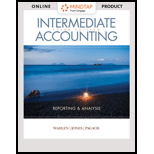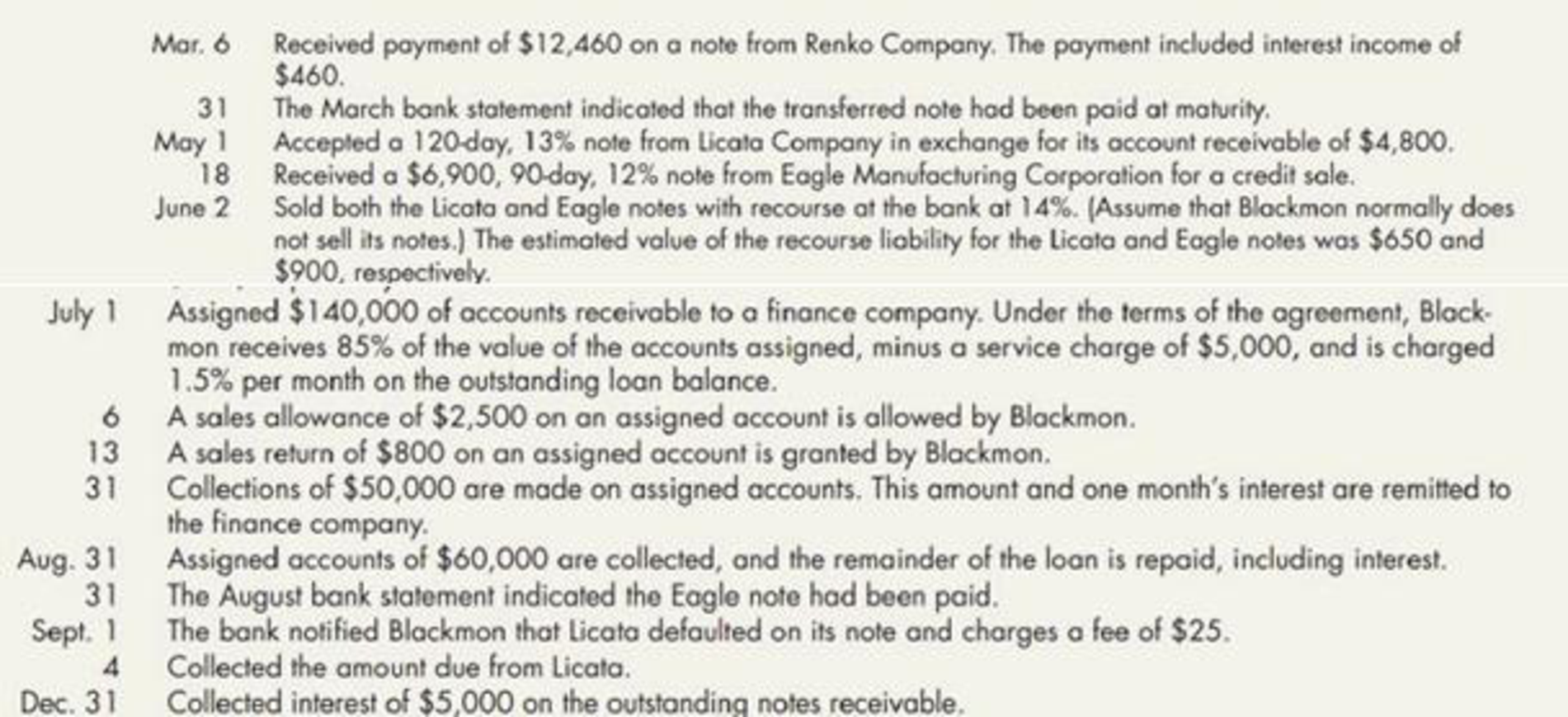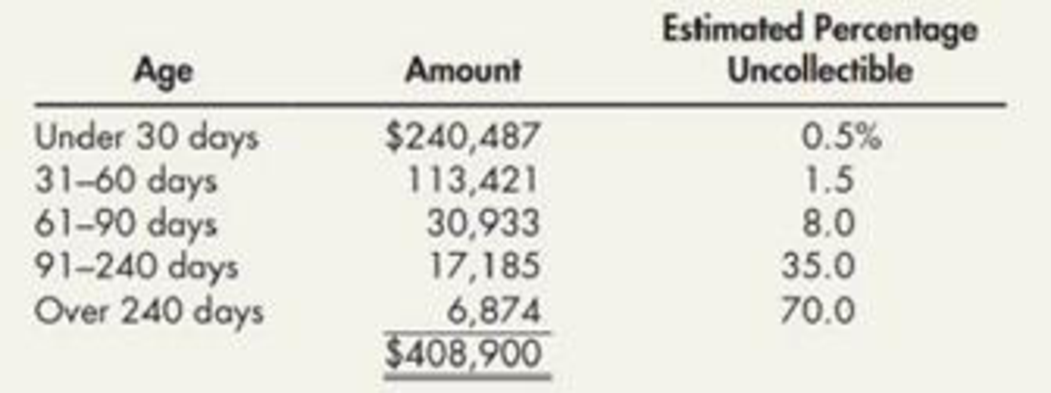
Concept explainers
Comprehensive Receivables Problem Blackmon Corporation’s December 31, 2018,

*The company has a recourse liability of $700 related to a note receivable sold to a bank.
During 2019, credit sales (terms, n/EOM) totaled $2,200,000, and collections on

On December 31, 2019, an aging of the accounts receivable balance indicated the following:

Required:
- 1. Prepare the
journal entries to record the preceding receivable transactions during 2019 and the necessaryadjusting entry on December 31, 2019. Assume a 360-day year for interest calculations and round calculations to the nearest dollar. - 2. Prepare the receivables portion of Blackmon’s December 31, 2019, balance sheet.
- 3. Next Level Compute Blackmon’s accounts receivable turnover in days, assuming a 360-day business year. What is your evaluation of its collection policies?
- 4. If Blackmon uses IFRS, what might be the heading of the section for the receivables reported in Requirement 2?
1.
Journalize the entries to record the previous receivables transaction and prepare the necessary adjusting entry on December 31, 2019.
Explanation of Solution
Accounts receivable:
Accounts receivable refers to the amounts to be received within a short period from customers upon the sale of goods and services on account. In other words, accounts receivable are amounts customers owe to the business. Accounts receivable is an asset of a business.
Prepare journal entries:
| Date | Account Title and Explanation | Debit | Credit |
| Accounts receivable | $2,200,000 | ||
| Sales revenue | $2,200,000 | ||
| (To record the sale on credit) |
Table (1)
| Date | Account Title and Explanation | Debit | Credit |
| Cash | $1,900,000 | ||
| Accounts receivable | $1,900,000 | ||
| ( To record payment received) |
Table (2)
| Date | Account Title and Explanation | Debit | Credit |
| Allowance for doubtful accounts | $18,000 | ||
| Accounts receivable | $18,000 | ||
| (To record accounts receivables written- off) |
Table (3)
| Date | Account Title and Explanation | Debit | Credit |
| Accounts receivable | $1,350 | ||
| Allowance for doubtful accounts | $1,350 | ||
| (To record accounts receivables written- off) |
Table (4)
| Date | Account Title and Explanation | Debit | Credit |
| March 6 | Cash | $1,350 | |
| Accounts receivable | $1,350 | ||
| (To record cash collected on accounts) |
Table (5)
| Date | Account Title and Explanation | Debit | Credit |
| March 6 | Cash | $12,460 | |
| Notes receivable | $12,000 | ||
| Interest income | $460 | ||
| (To record the cash collected from notes receivable along with interest) |
Table (6)
| Date | Account Title and Explanation | Debit | Credit |
| March 31 | Recourse liability | $700 | |
| Gain from sale of note | $700 | ||
| (To record the fair value of recourse liability) |
Table (7)
| Date | Account Title and Explanation | Debit | Credit |
| May 1 | Notes Receivable | $4,800 | |
| Accounts receivable | $4,800 | ||
| (To record the notes receivable) |
Table (8)
| Date | Account Title and Explanation | Debit | Credit |
| May 18 | Notes receivable | $6,900 | |
| Sales revenue | $6,900 | ||
| (To record the receipt of the interest bearing note) |
Table (10)
| Date | Account Title and Explanation | Debit | Credit |
| June 2 | Cash | $11,736 | |
|
Loss from sale of receivable | $1,603 | ||
| Notes receivable | $11,700 | ||
| Interest income | $89.97 | ||
| Recourse liability | $1,550 | ||
| (To record the factoring of accounts receivable) |
Table (11)
Note: For the values of amount refer to Table (26) and Table (27)
| Date | Account Title and Explanation | Debit | Credit |
| July 1 | Cash (balancing figure) | $114,000 | |
| Assignment service charge expense | $5,000 | ||
| Notes payable (11) | $119,000 | ||
| (To record the assignment service charge expense) |
Table (12)
| Date | Account Title and Explanation | Debit | Credit |
| July 1 | Accounts receivable assigned | 140,000 | |
| Accounts receivables | 140,000 | ||
| ( To record the remaining accounts owed) |
Table (13)
| Date | Account Title and Explanation | Debit | Credit |
| July 6 | Return liability | 2,500 | |
| Accounts receivable assigned | 2,500 | ||
| (To record the return liability of accounts receivable assigned) |
Table (14)
| Date | Account Title and Explanation | Debit | Credit |
| July 13 | Return liability | 800 | |
| Accounts receivable assigned | 800 | ||
| (To record the return liability of accounts receivable assigned) |
Table (15)
| Date | Account Title and Explanation | Debit | Credit |
| July 31 | Cash | 50,000 | |
| Accounts receivable assigned | 50,000 | ||
| (To record the receipt of accounts receivable assigned) |
Table (16)
| Date | Account Title and Explanation | Debit | Credit |
| July 31 | Notes payable | 50,000 | |
| Interest expense (12) | 1,785 | ||
| Cash | 51,785 | ||
| (To record the interest expense on notes payable) |
Table (17)
| Date | Account Title and Explanation | Debit | Credit |
| August 31 | Cash | 60,000 | |
| Accounts receivable assigned | 60,000 | ||
| (To record the receipt of cash) |
Table (18)
| Date | Account Title and Explanation | Debit | Credit |
| August 31 | Notes payable (15) | 69,000 | |
| Interest expense (13) | 1,035 | ||
| Cash | 70,035 | ||
| (To record the interest expense on notes payable) |
Table (19)
| Date | Account Title and Explanation | Debit | Credit |
| August 31 | Accounts receivable | 26,700 | |
| Accounts receivable assigned | 26,700 | ||
| (To record the accounts receivable assigned) |
Table (20)
Note:
| Date | Account Title and Explanation | Debit | Credit |
| August 31 | Recourse liability | 900 | |
| Gain from sale of notes | 900 | ||
| (To record the fair value of recourse liability) |
Table (21)
| Date | Account Title and Explanation | Debit | Credit |
| September 1 | Notes receivable dishonored | 4,383 | |
| Recourse liability | 650 | ||
| Cash (14) | 5,033 | ||
| (To record the notes dishonored) |
Table (22)
| Date | Account Title and Explanation | Debit | Credit |
| September 4 | Cash (14) | 5,033 | |
| Notes receivables dishonored | 4,383 | ||
| Gain from collection of dishonored note | 650 | ||
| (To record the ) |
Table (23)
| Date | Account Title and Explanation | Debit | Credit |
| December 31 | Cash | 5,000 | |
| Interest income | 5,000 | ||
| (To record the interest income) |
Table (24)
| Date | Account Title and Explanation | Debit | Credit |
| December 31 |
Bad debt expense | 17,855 | |
| Allowance for doubtful accounts | 17,855 | ||
| (To record the bad debt expenses of the period) |
Table (25)
Working note:
(1) Calculate the amount of loss from receivable:
| Particulars | Amount ($) |
| Face value of the note | 4,800 |
| Interest to maturity (2) | 208 |
| Maturity value of note | 5,008 |
| Less: Discount (3) | (171.38) |
| Proceeds | 4,836.62 |
| Less: Book value of note (4) | (4,855.47) |
| Recourse liability | (650) |
| Loss from sale of receivable | (668.85) |
Table (26)
(2) Calculate the interest to maturity:
(3) Calculate the amount of discount:
Note: 88 days is calculated by subtracting 120 days from 32 days (May 1 to June 2).
(4) Calculate the book value of note:
(5) Calculate accrued interest income:
Note: 20 days is calculated from November 1 to November 20.
(6) Calculate the amount of loss from receivable of Company E:
| Particulars | Amount ($) |
| Face value of the note | 6,900 |
| Interest to maturity (7) | 207 |
| Maturity value of note | 7,107 |
| Less: Discount (8) | (207.29) |
| Proceeds | 6,899.71 |
| Less: Book value of note (9) | (6,934.50) |
| Recourse liability | (900) |
| Loss from sale of receivable | (934.79) |
Table (27)
(7) Calculate the interest to maturity:
(8) Calculate the amount of discount:
Note: 75 days is calculated by subtracting 90 days from 15 days (May 18 to June 2).
(9) Calculate the book value of note:
(10) Calculate accrued interest income:
Note: 20 days is calculated from November 1 to November 20.
(11) Calculate the advance amount of accounts receivable:
(12) Calculate the amount of interest expense on July 31:
(13) Calculate the interest expense on August 31:
(14) Calculate the amount of cash on September 1:
(15) Calculate the amount of cash on August 1:
2.
Prepare the receivable portion of Company B as on December 31, 2019.
Explanation of Solution
Receivables portion of Company B is prepared as follows:
| Particulars | Amount | Amount |
| Accounts receivables (16) | $408,900 | |
| Less: Allowance for doubtful accounts (16) | ($16,205) | |
| $392,695 | ||
| Notes receivables | $38,000 | |
| Total receivables | $430,695 |
Table (28)
Working note:
(16) Calculate the estimated total amount of uncollectible:
| Age | Amount (a) | Estimated Percentage uncollectible (b) | Estimated amount of uncollectible |
| Under 30 days | $240.487 | 0.5% | 1,202 |
| 30–60 days | $113,421 | 1.5% | 1,701 |
| 61–90 days | $30,933 | 8.0% | 2,475 |
| 91–240 days | $17,185 | 35% | 6,015 |
| Over 240 days | $6,874 | 70% | 4,812 |
| $408,900 | $16,205 |
Table (29)
3.
Calculate the accounts receivable turnover in days and analyze its collection policy.
Explanation of Solution
Accounts receivable turnover:
Accounts receivable turnover is a liquidity measure of accounts receivable in times, which is calculated by dividing the net credit sales by the average amount of net accounts receivables. In other words, it indicates the number of times the average amount of net accounts receivables collected during a particular period.
Average collection period:
Average collection period indicates the number of days taken by a business to collect its outstanding amount of accounts receivable on an average.
Calculate the receivables turnover in days:
The receivables turnover in days for Corporation B is 51 days and it seems to be slow, therefore, the company must be very violent in its collection policies.
Working note:
(17) Compute the receivables turnover ratio:
(18) Calculate average accounts receivable (net):
4.
State the heading for the accounts receivable section in requirement 2, if Company B uses IFRS.
Explanation of Solution
“Loans and Receivables” can be used as the heading for the accounts receivables section, if Company B uses IFRS.
Want to see more full solutions like this?
Chapter 6 Solutions
INTERM.ACCT.:REPORTING...-CENGAGENOWV2
- Mit Distributors provided the following inventory-related data for the fiscal year: Purchases: $385,000 Purchase Returns and Allowances: $10,200 Purchase Discounts: $4,300 Freight In: $55,000 Beginning Inventory: $72,000 Ending Inventory: $95,500 What is the Cost of Goods Sold (COGS)?arrow_forwardanswer ? general accountingarrow_forwardBrightTech Corp. reported the following cost of goods sold (COGS) figures over three years: • 2023: $3,800,000 • 2022: $3,500,000 • 2021: $3,000,000 If 2021 is the base year, what is the percentage increase in COGS from 2021 to 2023?arrow_forward
- Sun Electronics operates a periodic inventory system. At the beginning of 2022, its inventory was $95,750. During the year, inventory purchases totaled $375,000, and its ending inventory was $110,500. What was the cost of goods sold (COGS) for Sun Electronics in 2022?arrow_forwardi want to this question answer of this general accountingarrow_forwardA clothing retailer provides the following financial data for the year. Determine the cost of goods sold (COGS): ⚫Total Sales: $800,000 • Purchases: $500,000 • Sales Returns: $30,000 • Purchases Returns: $40,000 • Opening Stock Value: $60,000 • Closing Stock Value: $70,000 Administrative Expenses: $250,000arrow_forward
- subject : general accounting questionarrow_forwardBrightTech Inc. had stockholders' equity of $1,200,000 at the beginning of June 2023. During the month, the company reported a net income of $300,000 and declared dividends of $175,000. What was BrightTech Inc.. s stockholders' equity at the end of June 2023?arrow_forwardQuestion 3Footfall Manufacturing Ltd. reports the following financialinformation at the end of the current year: Net Sales $100,000 Debtor's turnover ratio (based on net sales) 2 Inventory turnover ratio 1.25 fixed assets turnover ratio 0.8 Debt to assets ratio 0.6 Net profit margin 5% gross profit margin 25% return on investments 2% Use the given information to fill out the templates for incomestatement and balance sheet given below: Income Statement of Footfall Manufacturing Ltd. for the year endingDecember 31, 20XX(in $) Sales 100,000 Cost of goods sold gross profit other expenses earnings before tax tax @ 50% Earnings after tax Balance Sheet of Footfall Manufacturing Ltd. as at December 31, 20XX(in $) Liabilities Amount Assets Amount Equity Net fixed assets long term debt 50,000 Inventory short term debt debtors cash Total Totalarrow_forward
 Intermediate Accounting: Reporting And AnalysisAccountingISBN:9781337788281Author:James M. Wahlen, Jefferson P. Jones, Donald PagachPublisher:Cengage Learning
Intermediate Accounting: Reporting And AnalysisAccountingISBN:9781337788281Author:James M. Wahlen, Jefferson P. Jones, Donald PagachPublisher:Cengage Learning Cornerstones of Financial AccountingAccountingISBN:9781337690881Author:Jay Rich, Jeff JonesPublisher:Cengage Learning
Cornerstones of Financial AccountingAccountingISBN:9781337690881Author:Jay Rich, Jeff JonesPublisher:Cengage Learning

